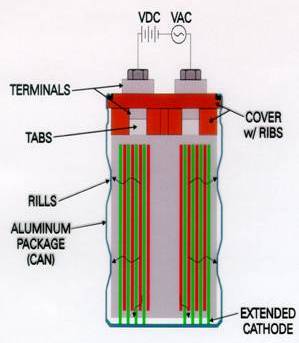Difference between Capacitor and Condenser
Key Difference: Capacitor is a device that is used to store an electric charge. It is basically an arrangement of conductors. Condenser is an old term for a capacitor. Therefore, there is no difference between a capacitor and condenser in electronics. However in other disciplines, condenser may also refer to a number of other things. For example – the term is also used to denote a device or unit which condenses a substance by cooling it. It refers to the change of state from its gaseous to its liquid state. ‘Condenser’ also denotes an optical system which concentrates light rays from a wide spread source into a narrow beam.
 In the world of electronics, capacitor and condenser are the same. However, only few may encounter with the word known as condenser, as it is now an obsolete term. The capacitor was invented in the year 1746, by a Dutch scientist named as Van Mussenbrock. Initially, it was known be the name ‘Leyder Jar’, as it was made using a glass jar filled with water. This jar was charged with static electricity. This jar was capable of storing electric charge in a very small space, and hence the name ‘condenser’ was born.
In the world of electronics, capacitor and condenser are the same. However, only few may encounter with the word known as condenser, as it is now an obsolete term. The capacitor was invented in the year 1746, by a Dutch scientist named as Van Mussenbrock. Initially, it was known be the name ‘Leyder Jar’, as it was made using a glass jar filled with water. This jar was charged with static electricity. This jar was capable of storing electric charge in a very small space, and hence the name ‘condenser’ was born.
Capacitor or condenser is a device that is used to store an electric charge. It is basically an arrangement of conductors. Due to its characteristics, a capacitor is widely employed in the formation of electronic circuits. Capacitor stores electrical energy directly, as an electrostatic field is created between two metal "plates". A capacitor is generally constructed using two metal plates or metal foils separated by an insulator known as a dielectric material. Any non-conducting substance can be used as a dielectric material. However, porcelain, mylar, teflon, mica, cellulose are generally preferred. A capacitor is defined by the type of dielectric and electrode material selected. It also defines the application of the capacitor. The dielectric material is the main substance that helps in storing the electrical energy.
The process of working of a capacitor and condenser can be described in the following steps –
- A capacitor is connected to a voltage source
- Current starts flowing and it flows until the capacitor gets fully charged
- Capacitor gets charged with an excess of electrons on one plate (- charge) and a deficiency of electrons on the other plate (+ charge).
- The dielectric which is present between the plates prevents electrons from moving between the plates.
- Electric current gets stored in the electric field for a short time.
Comparison between Capacitor and Condenser:
|
|
Capacitor |
Condenser |
|
Definition |
In capacitors, energy is stored in their electric field. |
Former name for a capacitor. |
|
Other meanings |
- |
Condenser is also used to denote a device or unit which condenses a substance by cooling it. It refers to the change of state from its gaseous to its liquid state.
‘Condenser’ also denotes an optical system which concentrates light rays from a wide spread source into a narrow beam. |
|
Uses |
High Voltage Electrolytic used in power supplies. Axial Electrolytic - lower voltage smaller size for general purpose where large capacitance values are needed. High Voltage disk ceramic - small size and capacitance value, excellent tolerance characteristics. Metalised Polypropylene - small size for values up to around 2µF good reliability. Subminiature Multi layer ceramic chip (surface mount) capacitor. Relatively high capacitance for size achieved by multiple layers. Effectively several capacitors in parallel. |
High Voltage Electrolytic used in power supplies. Axial Electrolytic - lower voltage smaller size for general purpose where large capacitance values are needed. High Voltage disk ceramic - small size and capacitance value, excellent tolerance characteristics. Metalised Polypropylene - small size for values up to around 2µF good reliability. Subminiature Multi layer ceramic chip (surface mount) capacitor. Relatively high capacitance for size achieved by multiple layers. Effectively several capacitors in parallel. |
|
Etymology |
1926, from capacity with Latinate agent-noun ending. |
Early 15c., from Middle French condenser (14c.) or directly from Latin condensare "to make dense". |
Image Courtesy: electrochem.cwru.edu









Add new comment